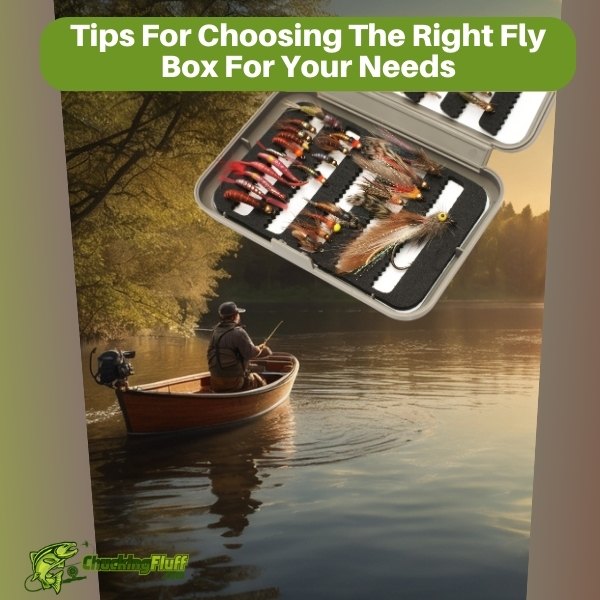| Disclosure: Just to be open and honest the buttons and links you click on in the website will in most cases take you to another website where you can purchase the products I am reviewing. As an Amazon Associate I earn from qualifying purchases. |
Tips For Choosing The Right Fly Box For Your Needs
Quick Post Navigation
- Understanding Fly Boxes
- Types of Fly Boxes
- Materials and Durability
- Size and Capacity Considerations
- Fly Box Organization Systems
- Selecting a Fly Box Based on Fly Types
- Fly Box for Different Fishing Scenarios
- Portability and Storage
- Waterproofing and Weather Resistance
- Budget Considerations
- Fly Box Brands and Recommendations
- How to Maintain and Clean Your Fly Box
- Common Mistakes When Choosing a Fly Box
- Conclusion
- FAQs
A fly box isn’t just a storage container — it’s your lifeline on the water. Imagine reaching for a dry fly during a perfect hatch, only to find your flies tangled, crushed, or rusted. Frustrating, right? That’s why choosing the right fly box is crucial for every fly fisher.
Your fly box protects your flies, keeps them organized, and makes switching patterns a breeze. But with so many options out there, how do you know which one to pick? Let’s break it all down, so you can find the perfect fly box for your fishing style and needs.
Understanding Fly Boxes
What Is a Fly Box?
A fly box is a compact container designed specifically for storing artificial flies. These boxes help keep your flies protected from damage and ensure they’re easy to access when needed. Think of it as a well-organized toolbox — every angler needs one to stay prepared on the water.
Basic Components of a Fly Box
Fly boxes may look simple, but they often have specialized components to keep your flies secure:
- Foam Inserts: Slits in the foam hold flies securely by their hook.
- Magnetic Strips: Small magnets hold delicate flies in place.
- Compartments: Individual sections for separating fly types.
- Waterproof Seals: Rubber gaskets to keep water out.
Understanding these features is essential when choosing a fly box that fits your needs.
Types of Fly Boxes
Fly boxes come in various designs, each suited for different fishing styles and conditions. Here’s a breakdown of the most common types:
Standard Fly Boxes
The classic choice for most anglers, featuring foam or compartments for securing flies. They’re versatile, lightweight, and work well for most fly types.
Waterproof Fly Boxes
Waterproof fly boxes have rubber seals and tight latches to keep moisture out. If you wade deep or fish in rainy conditions, this box will protect your flies from rust.
Magnetic Fly Boxes
These boxes use magnetic plates instead of foam to hold flies in place. They’re ideal for tiny flies, such as midges, where foam slits can feel too bulky.
Slimline Fly Boxes
Slimline boxes are ultra-thin and designed for minimalists. They fit easily into a shirt pocket but sacrifice some storage capacity.
Compartmentalized Fly Boxes
These boxes feature multiple small compartments to separate fly types. They work great for storing dry flies and nymphs separately.
Custom Fly Boxes
Want something unique? Custom fly boxes can be personalized with engraved designs, specific compartment layouts, or even made from premium materials like wood or leather.
Materials and Durability
The material your fly box is made from plays a big role in its durability and weight.
Plastic Fly Boxes
- Pros: Lightweight and budget-friendly.
- Cons: Less durable and prone to cracking.
Metal Fly Boxes
- Pros: Extremely durable and often corrosion-resistant.
- Cons: Heavier than plastic options.
Silicone Fly Boxes
- Pros: Flexible, durable, and waterproof.
- Cons: Pricier than other options.
Choosing the right material depends on how rough you are with your gear and the conditions you fish in.
Size and Capacity Considerations
How Many Flies Do You Need to Carry?
The size of your fly box depends on the number of flies you plan to carry. Are you going for a quick half-day trip or a multi-day adventure? If you’re traveling light, a small box should suffice. For longer trips, a large-capacity fly box might be better.
Balancing Capacity with Portability
A bigger box can store more flies but may feel bulky in your pack or vest. The trick is finding a balance where you have enough flies without overloading your gear.
Fly Box Organization Systems
The way your flies are organized affects how quickly you can switch patterns on the water.
Foam Slits
Foam slit boxes secure flies by the bend of the hook. They’re great for dry flies and nymphs, offering a secure grip and easy visibility.
Magnetic Strips
These boxes use magnets instead of foam, perfect for tiny flies like midges that can be hard to insert into foam slits.
Compartmentalized Boxes
Best for dry flies and larger patterns. Each fly has its own compartment, preventing tangling and damage.
Selecting a Fly Box Based on Fly Types
Different flies need different storage solutions. Here’s how to match your fly box to your patterns:
- Dry Flies: Use compartmentalized boxes or foam with plenty of space to avoid crushing delicate wings.
- Nymphs and Wet Flies: Foam slit boxes work best since nymphs are less fragile.
- Streamers: Go for larger boxes with deep compartments to avoid bending the fly.
- Mixed Collections: Opt for a versatile box with a combination of foam slits and compartments.
Fly Box for Different Fishing Scenarios
River Fishing
Compact, waterproof boxes work best since you’re constantly moving. Lightweight designs with basic compartments keep things simple.
Lake Fishing
You might need more fly variety when lake fishing, so a larger box with multiple compartments can help.
Saltwater Fishing
Saltwater environments demand corrosion-resistant fly boxes, preferably with a tight waterproof seal to protect your flies.
Portability and Storage
The perfect fly box fits seamlessly into your vest or pack without feeling bulky. Consider:
- Vest Pocket Fly Boxes: Small and slimline for quick access.
- Backpack Fly Boxes: Larger capacity for longer trips.
- Multiple Boxes: Some anglers prefer to carry multiple smaller boxes instead of one large one for better organization.
Waterproofing and Weather Resistance
Waterproofing protects your flies from moisture, preventing rust and damage.
- Fully Waterproof Boxes: Sealed with rubber gaskets.
- Splash-Resistant Boxes: Offers basic protection but not suitable for full submersion.
Budget Considerations
Affordable Fly Boxes
Great for beginners, these boxes focus on functionality over luxury. Basic plastic designs often fall in this category.
Premium Fly Boxes
High-end fly boxes are made from durable materials like silicone and come with advanced features like double-sided storage and waterproof seals.
Balancing Price and Features
While premium boxes offer durability, a basic box can be just as effective if well-maintained.
Fly Box Brands and Recommendations
Popular Fly Box Brands
- Umpqua: Known for premium, durable fly boxes.
- Fishpond: Stylish and functional fly boxes.
- C&F Design: Magnetic and foam options for all fly sizes.
Top Picks for Beginners
- Waterproof plastic fly boxes with foam slits.
- Clear lid boxes for easy fly visibility.
How to Maintain and Clean Your Fly Box
To keep your fly box in top shape:
- Rinse after saltwater use to prevent corrosion.
- Dry completely before storing to avoid mold.
- Check foam inserts regularly for wear and tear.
Common Mistakes When Choosing a Fly Box
- Overlooking Fly Type: Not all boxes suit every fly type.
- Choosing Size Over Function: A massive box isn’t practical for short trips.
- Neglecting Waterproofing: Wet flies = ruined flies.
Conclusion
Choosing the right fly box is all about matching your fishing style with the right features. Whether you’re a minimalist with a slimline box or a gear-heavy angler carrying a full range of flies, the right fly box can make your time on the water more enjoyable and efficient.
FAQs
1. What is the best all-around fly box?
A waterproof, medium-sized fly box with foam slits works best for most anglers.
2. How do I keep my fly box organized?
Sort flies by type and size, and consider labeling sections for faster access.
3. Can I use the same fly box for saltwater fishing?
Yes, but ensure it’s made from corrosion-resistant materials.
4. What’s the difference between dry fly and nymph fly boxes?
Dry fly boxes often have larger compartments to protect delicate wings, while nymph boxes focus on secure holding with foam slits.
5. How do I choose a fly box as a beginner?
Start with a standard waterproof fly box with mixed storage options for versatility.



